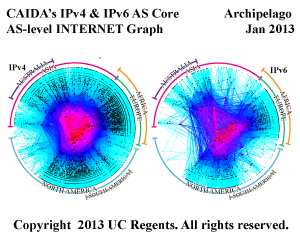IPv4 and IPv6 AS Core 2013
Friday, August 9th, 2013 by Bradley HuffakerWe recently released a visualization at http://www.caida.org/research/topology/as_core_network/ that represents our macroscopic snapshots of IPv4 and IPv6 Internet topology samples captured in 2013. The plots illustrate both the extensive geographical scope as well as rich interconnectivity of nodes participating in the global Internet routing system.
This AS core visualization addresses one of CAIDA’s topology mapping project goals is to develop techniques to illustrate structural relationships and depict critical components of the Internet infrastructure. These IPv4 and IPv6 graphs show the relative growth of the two Internet topologies, and in particular the steady continued growth of the IPv6 topology. Although both IPv4 and IPv6 topologies experienced a lot of churn, the net change in number of ASes was 3,290 (10.7%) in our IPv4 graph and 495 (25.7%) in our IPv6 graph.
In order to improve our AS Core visualization over previous years, this year we made two major refinements to our graphing methodology, including how we rank individual ASes. First, we now rank ASes based on their transit degree rather then their outdegree. Second, we now infer links across Internet eXchange (IX) point address space, rather than considering the IX itself a node to which various ISPs attach. Details at http://www.caida.org/research/topology/as_core_network/.
[For details on a more sophisticated methodology for ranking AS interconnectivity, based on inferring AS relationships from BGP data, see http://www.caida.org/data/active/as-relationships/.]
